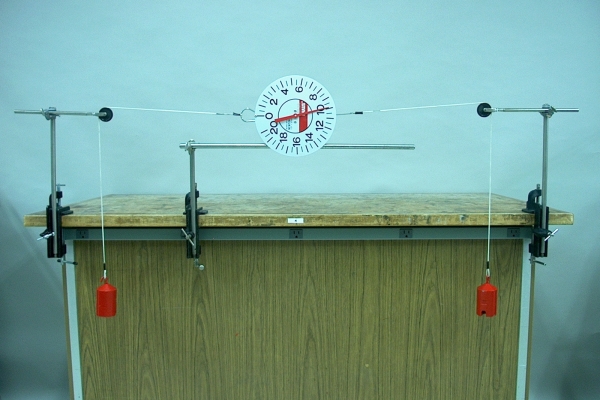
Both ends of a spring scale are connected to one-kilogram masses by ropes draped over pulleys. When you remove one of the masses from the rope and attach that rope end to the table clamp, the scale still reads 9.8 newtons.
This demonstration provides an illustration of Newton’s third law of motion, which states (as quoted in Resnick, Robert and Halliday, David. Physics, Part 1, Third Edition (New York: John Wiley and Sons, 1977), p. 79) To every action there is always opposed an equal reaction; or, the mutual actions of two bodies upon each other are always equal, and directed to contrary parts.
Usually, this demonstration is set out with the masses and scale resting on the table. The best way to hang the system is to hold the scale, and take the mass connected to either end of the scale, run its string over the pulley and set it hanging. Then, still holding the scale, take the other mass and run its string over its pulley and set the mass hanging. Then rest the dial of the scale on the horizontal rod as shown in the photograph. (This keeps the scale from flipping around, so that the class can read it.)
Before you hang the scale, you might ask the students what they expect it to read when you hang the mass. In this case, you would hold the scale and then hang the mass connected to the weighing hook of the scale. Then ask what they would expect if you hung the other 1-kg mass at the other side. To illustrate what is going on, you can then take the string from either mass and connect it to the screw on the table clamp, thus anchoring it to the clamp. As noted above, the scale reading does not change.
Gravity is pulling down on each mass with a force of mg, or (1 kg)(9.8 m/s2), or 9.8 N. So each mass exerts 9.8 N on its respective rope, one to the left and the other to the right. Since these forces act in opposite directions, and, in the sense that there is no net force, and thus no acceleration on any part of the system, they cancel. Actually, on each side there is also a force due to the weight of the ropes, but this is small enough that we may neglect it. We also neglect any drag over the pulleys, and take the tension as being the same everywhere along the two ropes.
In terms of “action-reaction pairs,” on each side, we have the the mass exerting tension in the rope, equal to its weight, and the rope, in turn, exerting tension, in the opposite direction, on the mass. In this demonstration as shown in the photograph, the tension the rope exerts on each mass is provided by the opposite mass. If you remove one mass, and then connect that end of the rope to the screw on the table clamp, the table clamp then provides this tension, and the action-reaction pair at that end, instead of being between the mass and the rope, is between the table clamp and the rope. In either case, the tension on the rope is the same. Hence the perhaps somewhat counterintuitive result that the tension on a string with two 1-kg masses hanging from it, each exerting 9.8 N, is 9.8 N.